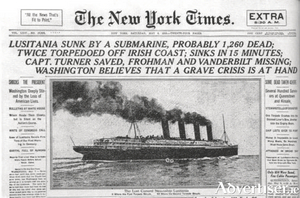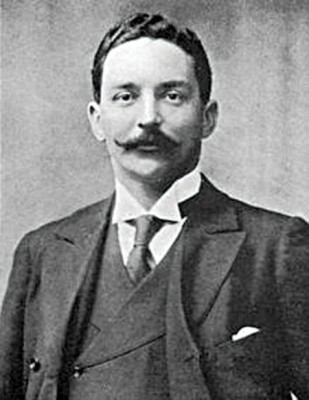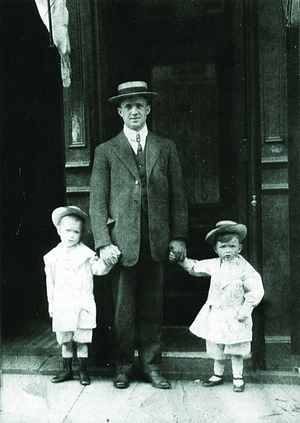Search Results for 'Queenstown'
11 results found.
How Ireland lost thirty nine famous paintings

The sinking of the Lusitania on May 7 1915, off the Cork coast, by a German submarine electrified Ireland, Britain and America. In Ireland, the fact that German submarines were lurking so close to the Irish shore, added fuel to the propaganda that Germany was planning to invade the country. It spurred recruitment into the armed forces. In Britain, the shameful practice of using passenger liners to carry munitions across the Atlantic without telling the passengers they were in effect travelling on a British war ship, was to come to an end.
‘The Hun was murdering Irish people in very waters of Cork’

The British ocean liner RMS Lusitania, famous for its luxurious accommodations and speed capability, primarily ferried people and goods across the Atlantic Ocean between the United States and Great Britain. On May 1, 1915, the Lusitania left port in New York for Liverpool to make her 202nd trip across the Atlantic. On board were 1,959 people, 159 of whom were Americans.
White Star chairman J Bruce Ismay finds peace in the west

On that terrible cold night of April 14 1912, in the North Atlantic, the Titanic was sinking head first into a freezing, calm sea. It had struck an iceberg 400 miles south of the Grand Banks of Newfoundland. And was fatally wounded. The incessant bip bip bip SOS call for help from the wireless telegraphist Jack Phillips and his assistant Harold Bride was interspersed with more dramatic calls for help: “We are putting passengers off in small boats. Women and children in boats, cannot last much longer”.
Eugene Daly, survivor of the Titanic

Eugene Daly was a 29-year-old weaver in Athlone Woollen Mills who decided to leave his job and go to America. He paid £6-19 for a third class ticket and boarded the Titanic at Queenstown. He was a piper and played native airs on board the tender on the way out to the liner. One of the survivors later sourly noted, “Looking astern from the boat deck, I often noticed how the third-class passengers were enjoying every minute of the time, a most uproarious skipping game of the mixed double was the great favourite whilst “in and out and roundabout” went a man with his bagpipes playing something that ‘faintly’ resembled an air.”
Easter Sunday march in Castlebar for Addergoole Titanic ‘14’ commemoration
In April 1912 14 men and women from Addergoole in north Mayo set sail from Queenstown, Cork, for a new life in America. Within days, 11 had died in the icy waters of the north Atlantic. Their ship, Titanic, sank on her maiden voyage.
Ford partners with Titanic project in Cobh

Ford Ireland has become a partner of the Titanic 100 Cobh 2012 centenary project with the provision of a pair of specially liveried new Galaxy models that will be used during the year-long commemoration.
Ford partners with Titanic project in Cobh

Ford Ireland has become a partner of the Titanic 100 Cobh 2012 centenary project with the provision of a pair of specially liveried new Galaxy models that will be used during the year-long commemoration.
Civil War - British gunboat sent to Clifden

June 22 1922 Galwegians looked on with alarm as anti-Treaty forces, who had taken up positions in a number of buildings in the city, including the former RIC station at Eglinton Street, were preparing for a fight. That morning Michael Brennan, IRA commander of the only major pro-Treaty unit in the west, under orders from Richard Mulcahy Free State Army commander, entered the city with a large well armed force. They immediately secured the county-jail, the courthouse, and the railway hotel. Having seen the end of the War of Independence, and having voted by a substantial majority just weeks before for parties supporting the Treaty with Britain, this was a tragic state of affairs. Galwegians feared an all out pitched battle, followed by the horrors of the previous years of struggle. This time, however, the enemy was not Britain, but former friends and comrades.
Lahardane bell tolling in memory of Titanic sinking
Ninety-nine years ago this weekend, 14 young emigrants from a tiny Mayo village under Nephin mountain bid their families and friends a bittersweet farewell. They were off to America, but first they had to walk the 12 miles over the Windy Gap, from Lahardane to Castlebar, before catching the first of many trains in order to reach Cobh.


